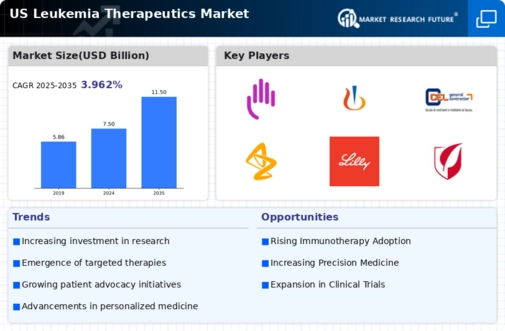Growing Incidence of Leukemia
The increasing incidence of leukemia in the US is a primary driver for the leukemia therapeutics market. According to the American Cancer Society, approximately 61,000 new cases of leukemia are expected to be diagnosed in 2025. This rising trend necessitates the development and availability of effective therapeutic options. As the population ages, the risk of developing leukemia escalates, further propelling the demand for innovative treatments. is thus positioned to expand significantly, as healthcare providers seek to address this growing patient population.. The urgency for effective therapies is underscored by the need for improved survival rates, which have historically lagged behind other cancers. Consequently, pharmaceutical companies are increasingly investing in research and development to create targeted therapies that cater to this rising incidence.
Increased Investment in Oncology Research
The leukemia therapeutics market is experiencing a surge in investment in oncology research, which is crucial for the development of new therapies. Public and private funding for cancer research has seen a notable increase, with the National Cancer Institute allocating approximately $6 billion for cancer research in 2025. This financial support fosters innovation and accelerates the development of novel treatment options for leukemia. Additionally, partnerships between pharmaceutical companies and research institutions are becoming more common, facilitating the sharing of knowledge and resources. This collaborative approach is likely to yield breakthroughs in treatment modalities, further propelling the leukemia therapeutics market. As new therapies emerge from this robust research environment, patients will benefit from improved treatment options and outcomes.
Rising Awareness and Education on Leukemia
Rising awareness and education regarding leukemia are contributing to the growth of the leukemia therapeutics market. Increased public knowledge about the symptoms, risk factors, and treatment options for leukemia is leading to earlier diagnosis and intervention. Organizations dedicated to leukemia awareness are actively engaging in campaigns to educate both patients and healthcare professionals. This heightened awareness is likely to result in more individuals seeking medical attention, thereby increasing the demand for therapeutic options. As patients become more informed about their treatment choices, the leukemia therapeutics market is expected to expand, driven by the need for effective therapies that align with patient preferences and expectations.
Regulatory Support for Innovative Therapies
Regulatory support for innovative therapies is a significant driver of the leukemia therapeutics market. The US Food and Drug Administration (FDA) has implemented various initiatives to expedite the approval process for breakthrough therapies, particularly in oncology. Programs such as the Breakthrough Therapy Designation and Accelerated Approval pathway are designed to bring promising treatments to market more swiftly. This regulatory environment encourages pharmaceutical companies to invest in the development of novel therapies for leukemia, as the potential for rapid market entry is appealing. Consequently, the leukemia therapeutics market is likely to see an influx of new treatments that can address unmet medical needs, ultimately benefiting patients and healthcare providers alike.
Technological Advancements in Drug Development
Technological advancements in drug development are reshaping the landscape of the leukemia therapeutics market. Innovations such as artificial intelligence and machine learning are streamlining the drug discovery process, enabling faster identification of potential therapeutic candidates. These technologies facilitate the analysis of vast datasets, which can lead to the discovery of novel compounds and biomarkers. Furthermore, advancements in genomic sequencing allow for personalized medicine approaches, tailoring treatments to individual patient profiles. This shift towards precision medicine is likely to enhance treatment efficacy and minimize adverse effects. As a result, the leukemia therapeutics market is witnessing a surge in the introduction of new therapies that leverage these technological advancements, ultimately improving patient outcomes and driving market growth.






















Leave a Comment